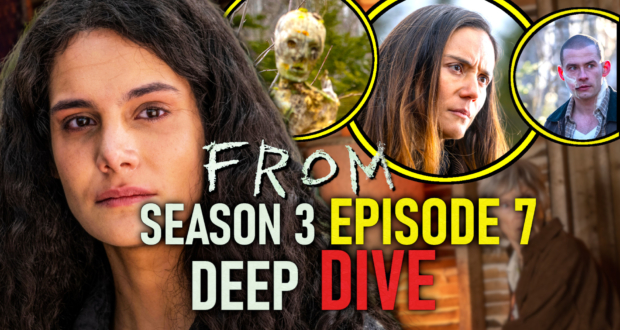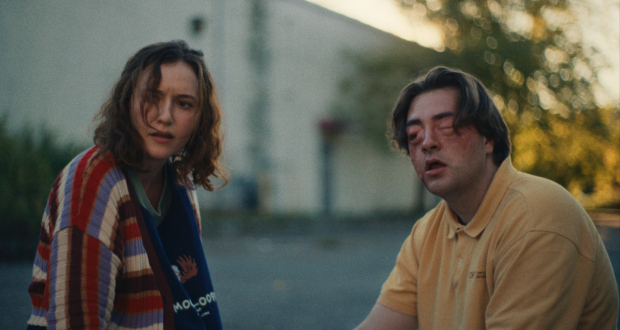As I sat in a decent if still terrible pizza place, dejected and awash with defeat after missing yet another of my preplanned film viewings on the trip (this one due to a theater location being much farther away than I had realized), and watching a fellow festivalgoer suck on chicken wings with the gross precision of a well-traveled barbarian, I figured my coverage of the 2016 Sundance Film Festival—the first of my young career as a critic—would go down as a quirky, ultimately enjoyable learning experience, at best. When I first booked my plane tickets, I did so with a mantra in mind—a film critic isn’t a film critic until they have covered a film festival. This was my way of justifying the hit to my wallet. Yet after two whole days in the crisp mountain air of Park City, Utah, home to the most popular American film festival there is today, I realized I might have to amend my motto to something more forgiving. Something like, “a film critic isn’t a film critic until they are in the same town as a film festival.”
That has a certain hollow ring to it, don’t cha think? I had “covered” the festival like a couch potato might “cover” the Super Bowl—keeping the event superfluous with a steady flow of food, friends, and alcohol, but still reserving the right to have a strong and uninformed opinion at the end. Paraphrasing one movie industry insider’s summation of the festival (who, between grotesque and possibly nervous sucks on his drool soaked scarf, shared them with a wisp of insider cockiness): who cares if you only see a couple flicks? Most people will see two movies in a week and think it more than enough. And my response to that is touché, sir. I guess actually seeing the movies playing at a film festival is best left for the birds.
To be fair to myself, Mother Nature was the unassailable roadblock in my mostly failed bid to conquer Sundance. My trip was supposed to be for four days, and I had frontloaded my viewing schedule so as to give myself time to write on the backend. Instead, She spanked the east coast with a blizzard just severe enough to shut down all fights for a day-and-a-half. That left me with just two days to see whatever I could, and my viewings of Werner Herzog’s documentary (LO AND BEHOLD), Todd Solondz’s new oddity (Wiener-Dog), and Rebecca Miller’s star-studded affair (Maggie’s Plan) would have to be scrapped. It also meant I’d be fighting tooth and nail to get into hot topics like the fart filled Swiss Army Man; Kevin Smith’s potentially floppy sequel to Tusk, Yoga Hosers (starring Johnny Depp’s daughter, in a case of “I guess I care?” celebrity appeal); the record-breaking Nat Turner story by filmmaker/star, Nate Parker, The Birth of a Nation; really, anything I wanted to see wound up a dead-end. Though I did get to see plenty of people shopping and gabbing (yours truly being one of the biggest culprits), I suppose there were many cinephiles lurking down the cold main street of Park City in anticipation of being the first to give a thumbs up, down, or sideways to many of the same films I wanted to check out.
Travel at Sundance is another issue I couldn’t, for the life of me, navigate. Though a proficient shuttle service ushers you to the many theater screens working in conjunction with the festival, still some were a ways too far away. I didn’t know this pertinent information, and so my viewing of Rob Zombie’s NC-17 horror spectacle, 31, wound up as nothing more than a ripped ticket stub sitting next to my thin-crust, bowling alley style pizza. A commitment to see a Serbian film worked on by an old friend (the film: A Good Wife, the friend: filmmaker Dark Lungulov) would be broken by dint of the distance from Park City to Salt Lake, and by the slow moving lines at a wonderful little shop selling enough rhinestone cowboy gear to make Greg Campbell blush, a Star Wars blanket set worth two-thousand dollars, and other Star Wars themed blankets running at a much more affordable price of two-hundred dollars, costing me valuable time on the freeway. In short, I bought some pants and missed a movie. So it goes.
As I ripped the ticket up, a friend became incensed. What was I doing, he yelled. Sell the ticket! People are always looking for scalpers at Sundance. Who knew? But I didn’t come all that way to make thirteen dollars in cold, hard cash. At that moment, if I was to be robbed of yet another movie, then I was going to ensure nobody would be able to have my seat. Of course, with the wait list program and all, that would prove impossible to guarantee. But it was my ticket! And if I wanted to rip it up, then rip it I would. I could take some solace in the fact that my fellow TMB contributor, Kenny Miles, was able to see some of the true spotlight features of the festival (notably Apichatpong Weerasethakul’s Cemetery of Splendor and Ciro Guerra’s Embrace of the Serpent), so at least someone was getting around Sundance. But one lesson I did learn—enjoy life.
My trip may not have been full of movies, but it was a great time with close friends in and around the industry I love. I ate terrible food (no disrespect, Park City, but the meals stunk, and the price gouging was real. Although, I will shout-out The Eating Establishment for some bomb breakfasts, and the fries-and-curry-sauce at a pub called Flanagan’s that rocked my world), sucked up the fresh air, and reveled at the mountains surrounding me. The mountain ranges made me feel so small and like nothing, the pessimist in me nearly came to orgasm with a rush of divine insignificance. Mother Nature can be really unfair sometimes, but also majestic and truly moving.
I must stress that Sundance is not a moviegoer’s paradise. There is an unshakable vibe of people looking to network, to party, and to wear cool winter gear. The films feel secondary, and that’s not a good thing. The other festival in town, Slamdance, known for its daring programming, if not necessarily for its quality of cinema, was in full force. A friend I traveled with, Spencer Holden, had a film in Slamdance (After Muybridge, a short experimental work), and was a programmer (a grueling task). I will be reviewing his film in the coming weeks, as part of a closer look at experimental film I intend to take (I have yet to plunge into the deep end of experimental cinema, but I’ll dip a toe in and report back to you all), but I will say that Spencer is a brilliant contributor to cinema, and being on the trip with him was a blast. Friends are worth their weight in gold, and that is my most important takeaway from Sundance 2016. Oh, and of course, I ended up wandering into a couple of films. Here is my recap of what I was able to see.
The Lobster, Yargos Lanthimos

Starring Colin Farrell, Greek sensation Yargos Lanthimos brings us his first English-language film, a surreal adventure into the pressures of companionship, the stigmas of being alone, and the general wackiness and provocations of a director with a slightly petulant obsession for wackiness and provocation. Though I haven’t seen much of Lanthimos’ work (Alps, Kinetta, My Best Friend are among the unknowns), I, and everyone in the movie-going world, saw his 2009 feature, Dogtooth. I didn’t love it, but I certainly saw in it an energy and mania that was intriguing. However, after this most recent film from Lanthimos, I may have to reevaluate said intrigue.
Enter The Lobster, a film that plateaus within its first twenty minutes and nosedives much in a similar fashion to how I felt Fight Club did. I know it’s a strange connection, but both films deal with a type of surrealist plot that doesn’t seem to know where to go, and so they spiral deeper down the rabbit hole until the whole thing seems too silly to admire (and both films’ plots plug anarchist groups into the climax). It appears Lanthimos has taken a step laterally, and ended up on his heels.
Farrell plays David, a man living in a dystopian future where those who are living single are seen as outcasts, and are rounded up and transferred to The Hotel where they have forty-five days to secure a companion, or they will be turned into an animal of their choosing for the rest of their days. David’s wife has left him, and his brother is already a dog, literally, and so David leashes little bro and heads off to captivity among the other lonely, chubby, damaged losers. But there’s also a rebel group of loners living in the woods, with equally stringent rules and ridiculous punishments for those who break them. Essentially, The Lobster runs all the same gimmickry back in its second half, transferring attention from the institutional silliness of The Hotel to the cold and unforgiving woods where the loners roam.

Whenever a siren blares at The Hotel, everyone grabs a dart gun and goes hunting for loners. The more they bag, the more days they get to avoid the ultimate punishment of becoming a jackass. But taking us into the woods to see the perspective of the loners was a bad choice, as it not only made the entire film seem like a series of hit-or-miss adult gags (draped in violence in a way that makes us appreciate Quentin Tarantino all the more), it underscored the film’s lack of nuance. Plot wise, it has function (a budding romance between David and a loner is the crux of the film), but it just wasn’t worth the time spent.
Farrell, who packs on the chunk so that we understand how much of a lonely loser he is, gives one of his most deadpan performances. He hardly winces at his bizarre surroundings, even as the plot gets “stranger” and “stranger” (yes, two sets of quotations are necessary for the forced fantasticality Lanthimos pushes on us). His keeping his wits about him in robotic determination is the spirit of the entire film. Despite the comforting quirkiness of John C. Reilly, whose mode of performance fits in as well here as in most any movie he’s in, the not-so-quiet desperation of Ashley Jensen stealing at least some of the show, Rachel Weisz’ adequate work in the latter-half of the film as Farrell’s romantic interest, and Lea Seydoux’s relentless toughie act as the leader of the loners, there really isn’t much to highlight in the positive. I basically enjoyed only the performances, and that depressed me to no end. Oh, and I enjoyed seeing a little Fred Murtz in the way character actor Garry Mountaine belted out a tune at a High School dance-esque party at The Hotel. William Frawley is God.
A plateauing plot is not necessarily a bad thing. Paul Thomas Anderson’s The Master is a prime example of when letting the plot drift works well. That film is one of the greatest of all-time, and, plot-wise, it goes nowhere. Lanthimos’ Dogtooth, too, doesn’t go anywhere once its conceit and its narrative are defined. But it didn’t seem to halt its momentum. Yet, something about The Lobster felt anxious, like it was trying too hard to be both funny and horrifying, while also being vaguely philosophical enough to prove there was more to this gaudy entertainment. But Lanthimos painted himself into a corner. The movie is all provocation, one seemingly bigger than the next, and he doesn’t appear to have a handle on just how to do this without slipping into being overly crude. There’s a rape joke, for example, and it’s in poor taste (despite the audience lapping it up, I just couldn’t muster the mantra to “loosen up” and join in on the laughter). There’s also a shot of a mutilated dog that didn’t add much to the proceedings beyond the gasp effect. A lot of these reaches didn’t quite fit right. But, hey, at least there were some non-mutilated animals, and animals are always fun to look at—they are so cute! All of them!
The Free World, Jason Lew

Oh boy, where to start with this dump truck? For one, the main character, Mo Lundy (Boyd Holbrook), is a white guy fresh out of prison, and he has found God in Islam. Yes, a southern white boy is named Mohammed (shortened to “Mo”) and is seen praying with the proper handful of beaded necklace. Why is this a problem? Well, why isn’t it? Why is Joseph Fiennes set to play Michael Jackson in a biopic of the pop star? Why does the literal translation of “Islam” (meaning “surrender”) seem to be the only purpose of having a Muslim character in this movie? Themes are great and all, but can’t we just take a break from whitey-as-not-whitey for one film? I’m white, too, and trust me I’ve had enough of us. Making us into Michael Jackson, or having us praying on our knees while pointed towards Mecca, will not persuade the general public that we aren’t only pearly skinned and flaky. I’m not here to advocate for a boycott of the Oscars, I’m here to advocate a boycott of all films that lack meaningful diversity. I missed the bombshell release of Sundance, Nate Parker’s Nat Turner-centric film, The Birth of a Nation (bought for distribution for a record 17.5 million dollars at the festival), but hopefully this is a sign of a changing of the times, and that there will be fewer Mo’s in our cinema scene.
Back to the film: Mo was in prison from his teenaged years to his present, and in that time he acquired nicknames like “The Cyclops” and “The Beast of Angola.” He gouged out his fair share of eyes while in prison, and apparently disfiguring inmates doesn’t add onto your sentence, so he was released when he was proven innocent of the crime he was originally convicted for. Now out in the “free world,” he can’t cope with all the damn freedom. Of course, the “freedoms” he enjoys involve being harassed by the local police, working a cruddy job at an animal shelter (where he connects with the dogs, because, you know, they live in cages and are damaged goods, which, if you follow metaphors with even the slightest bit of acumen, you’ll understand that Mo is a caged animal), and living life like he did back in the pen by sleeping in the closet and having not a single piece of Ikea furniture in his apartment. Things only get worse/better when he meets Doris (Elisabeth Moss), a woman who has committed a crime of passion-gone-rotten and needs the help of a fellow sexy criminal.
Okay, I’m being a little cruel, but I just can’t stand this kind of paint-by-numbers indie craftsmanship. This is a love-on-the-run story, and I wished the entire time it would go the way of the end of Thelma and Louise, or better yet, that it stopped and the projectionist just rolled Thelma and Louise instead. There’s too much pat indie gooeyness on all fronts to overcome. The score, the camerawork (all sun-through-the-trees and cloud coverage), the acting, the script, everything stinks to high heaven. Holbrook, especially, is a mess of overacting. His vibe is all Clint Eastwood from Unforgiven, except about a hundred times less badass and genuine. And Moss, to her discredit, doesn’t seem to understand the psychology of her character at all—or maybe her character has no psychology, and so she channeled Peggy Olson’s charm (later-season Olson, of course) and ran with it. This movie is a mess from top to bottom.
First time director Jason Lew is guaranteed to make other films. And many, many directors have a few stinkers to their credit. That he made it to Sundance as a filmmaker is a coupe. That his movie stinks means he’s truly arrived.






















